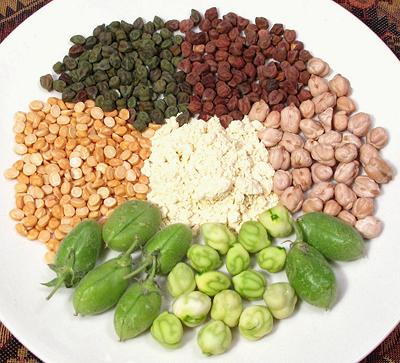 [Garbanzos (Spanish - from Basque), Ceci (Italy), Chiche (France),
Chana / Bengal Gram (India), Cicer arietinum]
[Garbanzos (Spanish - from Basque), Ceci (Italy), Chiche (France),
Chana / Bengal Gram (India), Cicer arietinum]
Originating probably in southeastern Turkey, these "peas" were taken to India and to the Mediterranean region in prehistoric times. We know they have been cultivated for over 7500 years, and today remain prominent in the cuisines of both regions. Chickpeas require a warm dry climate so in the U.S. they are grown mainly in California and Arizona. They are grown in other parts of the country but yields decline with temperature.Production is increasing rapidly in developing countries, particularly in Western Asia.
The photo shows chickpea flour (besan) in the center and clockwise from the top green and red Bengal gram (Desi type chickpeas), light colored Kabul type chickpeas, fresh Kabul type chickpeas and pods, and Chana Dal (split and peeled Bengal gram.
More on Beans, Peas and Lentils
 [Bengal Chickpeas, Kala Chana, Chana Dal, Bengal Gram (India);
Shimbra (Ethiopia)]
[Bengal Chickpeas, Kala Chana, Chana Dal, Bengal Gram (India);
Shimbra (Ethiopia)]
One of the most important crops in India, these chickpeas are closer to the wild chickpeas of southeastern Turkey than are the familiar Mediterranean (Kabuli) type. Desi is the preferred type for growing in hotter regions.
Shown in the photo are red and green varieties along with Chana Dal (split and peeled chana) and Besan or Gram Flour (chickpea flour ground from the dal). Dalia [Pappulu, Bhuna Chana], a roasted peeled and split Bengal Gram is not shown. It looks just like Chana Dal, but is almost powdery in texture and easily ground. Dal is used more than the whole peas because it cooks much faster, important in a fuel poor country. The red peas in the photo were around 1/4 inch in diameter and weighed about 155 to an ounce (19 gm / 100), the green slightly smaller. Details and Cooking.

[Garbanzo (Spanish); Kabuli Chana, Safed Chana (India); Ceci (Italy); Chiche (France); Hommes, Hamaz (Arab); Nohud, Lablabi (Turkey)]
These are the large light colored chickpea so familiar in the Mediterranean region, the Near East and North America. They were not introduced into India until the 18th century and came there through Afghanistan, thus named for the Afghan capital of Kabul.
Kabuli is the preferred type for growing in more temperate climates. The photo shows dried peas on the left, fresh pods top right and freshly shelled peas on the lower right. The dried peas in the photo were about 3/8 inch in diameter and weighed about 50 to an ounce (56 gms / 100). Details and Cooking.